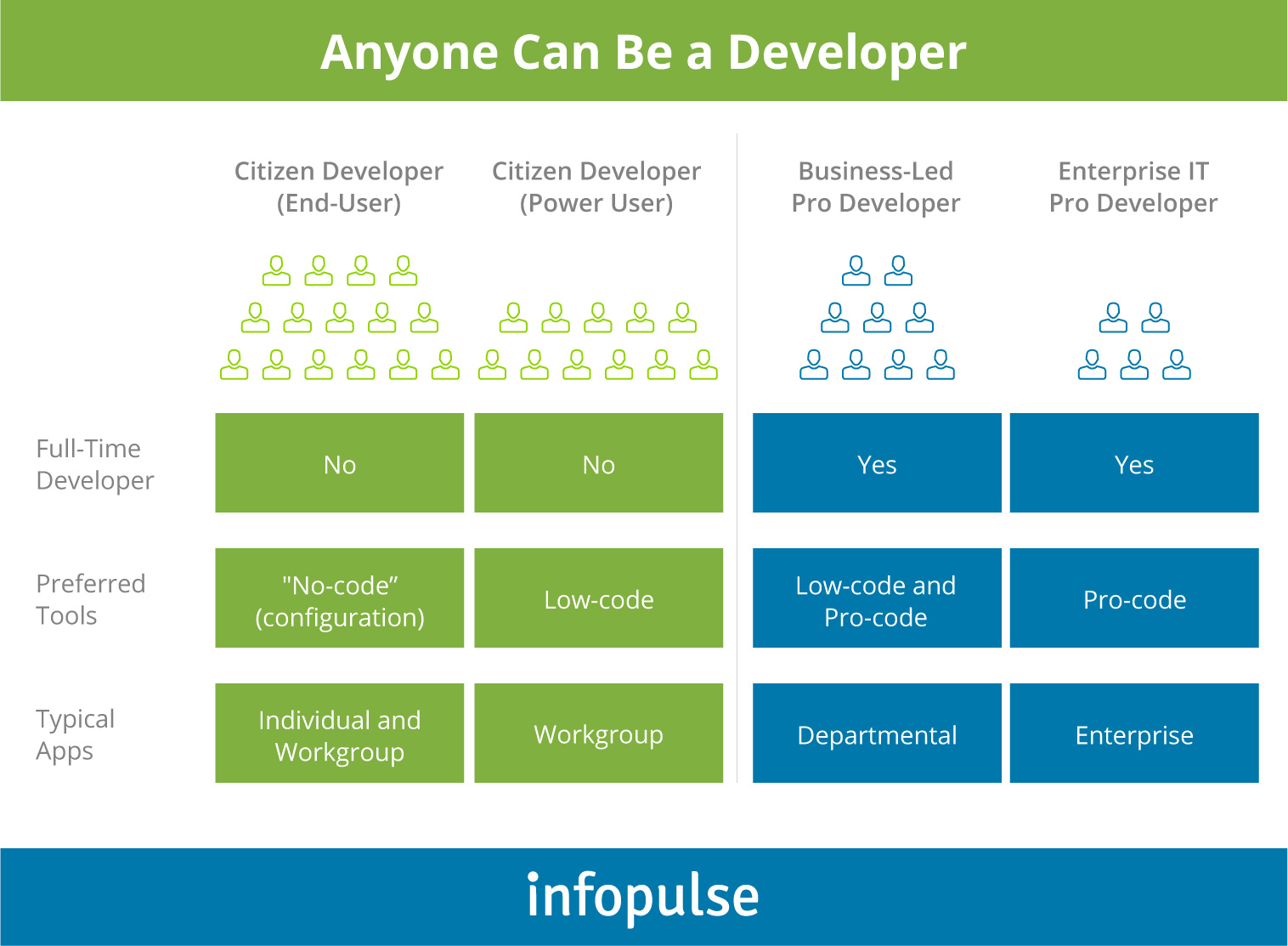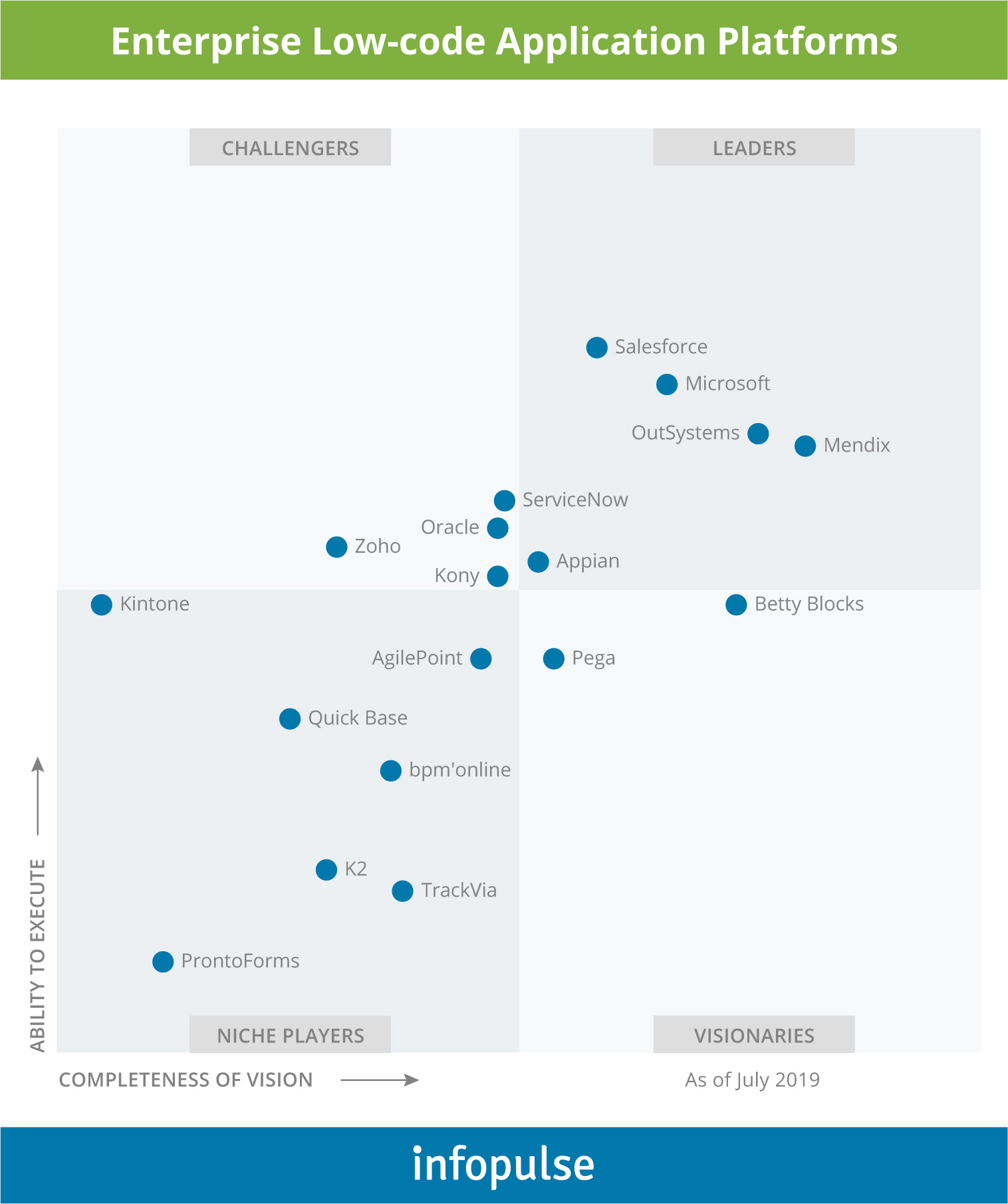The Benefits of Implementing Low-code Development Platforms
Those promises may resonate with a lot of companies. So much so that by 2024, 65% of applications are predicted to be built using low-code development platforms. Should enterprises join this trend? We believe yes, as low-code development adoption results in a host of attractive benefits.
However, before we dive into the post-adoption results, let’s settle on the key industry terms.
What Is Low-code Development and Citizen Development?
The name is a bit of a giveaway. A low-code development platform lets users build new software graphically with the help of user interfaces and configuration instead of writing code from scratch.
Gartner provides the following definition for this trend:
“A low-code application platform (LCAP) is an application platform that supports rapid application development, one-step deployment, execution, and management using declarative, high-level programming abstractions, such as model-driven and metadata-based programming languages. They support the development of user interfaces, business logic, and data services, and improve productivity at the expense of portability across vendors, as compared to conventional application platforms.”
Low-code platforms minimize the need for native programming as the majority of app functionalities can be assembled using graphic elements, pre-written, and reusable code blocks. In most cases, developers only need to program more complex or custom aspects of the app.
Gartner’s October 2019 report estimates that:
- 66% of LCAP users are professional developers
- 2% are business analysts.
Additionally, some organizations (41%) also involve business users in low-code app development as most LCAPs require specific inputs for process flow descriptions and business logic.
Another term frequently used along with or instead of LCAP is “no-code development.”
So is it possible to create apps without writing a single line of code? Despite the marketing promises from some platforms, that’s rarely the case. Here’s why:
- Certain apps may require tools and integrations that low-code development platforms do not provide. While it is possible to drag & drop up to 70% of the app, the remaining 20%-30% must be coded.
- Integrating the new app within your system in most cases requires programming expertise. So do any UI customizations or custom reporting functionality.
The bottom line: no-code application development can be achieved only at particular projects. Others will require coding expertise.
However, the definitive draw of LCAP platforms is that they enable a larger group of users to participate in app development, and thus, become a citizen developer.

Citizen development is picking up speed. According to a Salesforce survey, 25% of companies already use low-code and no coding platforms. An additional 41% plan to start doing so within the next two years.
Those who have already established the citizen development practice report the following benefits:
- Reduced load on the main IT department
- Less shadow IT
- Improved business agility and staff efficiency
- Increased app speed production and higher ROI
- Reduced app development costs.
QuickBase estimated that 62% of citizen developers need less than two weeks to complete a new app. Additionally, 71% of the surveyed citizen developers managed to increase their app development speed by at least 50% within a year of usage.
To sum up, low-code app development platforms simplify and streamline app development by eliminating the need to write custom code. However, there are certain limits to how far you can go with “no-code” and citizen development only.
In the next part of the post, we’ll focus on showcasing the benefits and possibilities of low-code application development.
Where Low-code Development Generates the Most Value for Enterprises
Low-code development platforms are mainly used to build “get work done” apps. Such software streamlines and automates repetitive low-value tasks and helps improve operational efficiency.
These apps may include:
- Business process managing applications
- Project management applications
- Database management applications
- Innovation applications
- Legacy migration apps.
For instance, Verité, a global non-profit organization with engagements in 70 countries, used low-code development to improve its project management reporting and data centralization. With the help of QuickBase, the team shipped new functionality that resulted in:
- A $24,000 increase in efficiency
- $80,000 of software development cost-savings.
Additionally, you can use LCAPs to build a variety of external customer engagement apps and mobile solutions. Furthermore, you can take advantage of a variety of other internal and external apps that are not readily available off the shelf.
Using a low-code application development platform makes the most sense when:
- Already available solutions are too expensive/complex or do not fully meet the needs of your organization.
- You want to exercise more control over future product capabilities.
- The application is a standard business use case (supported by an LCAP).
- You want your business users to be empowered to create their apps.
Existing industry examples best illustrate the full spectrum of benefits of low-code development.
Examples of Low-code Applications for Enterprises
Process Automation Applications
As part of legacy system modernization, Morrison & Foerster needed to migrate 2,500+ users across 16 offices and three continents to new software. To improve efficiency, the company created custom progress dashboards on ServiceNow and automated the majority of checklist tasks within their custom app built with low-code tools. The IT department has saved the estimated 9,840 person-hours.
ServiceNow is a popular ITSM platform, also providing low-code enterprise application development tools. We’ll cover the basics of building enterprise apps on ServiceNow in our next post.
Proof-of-Concept Apps
The era of digital transformations is upon us, and most enterprises are pressured to innovate at break-neck speed. Agile low-code development is a robust way to test new product ideas and integrations without “going all in”.
Shell Downstream, for example, relies on Salesforce to create quick proof-of-concept app mockups whenever they are exploring a new tech use case. Additionally, the company now uses low-code to build apps for HR, sales, marketing, and M&A teams. In a recent interview, the company’s CIO Craig Walker admitted: “We only want to write our own code where we truly differentiate with IP and knowledge to gain a competitive edge in the market”.
In other cases, they use Salesforce low-code tools to deliver new software for in-house teams and retail locations.
Companion Mobile Apps
Kelly Roofing, one of the largest roofing contractors in Collier County, Florida, decided to improve the productivity of on-site workers and improve the photo/data reconciliation process. Before using the Power Apps platform by Microsoft, every contractor had to input the data in the company’s Dynamics 365 manually. It was a tedious and error-prone process that consumed a lot of productive time.
Using Power Apps, Kelly Roofing deployed a new companion mobile app that contractors could use to take photos, automatically upload and categorize them in the CRM, input other job information and share it with customers in one click.
Post-adoption, Kelly Roofing gained the following benefits:
- 36% drop in customer callbacks as they could now gain real-time updates within the app.
- 91% decrease in processing time as the app automates photo reconciliation.
- Almost 26% reduction in trip time due to improved scheduling.
Employee Onboarding App
Microsoft recently deployed a new Thrive suite, built entirely on their PowerApp platform. Thrive is a proprietary web and mobile HR application that unifies the employee experience for the company’s 100,000+ hires.
The app lets users set vacation time and days off, network and connect without other folks on their team and cross-department, access employee directory, and review paystub information. Thrive also includes a separate HR conferencing app, developed specifically for one of the company’s events.
Pat Dunn, Program Manager at Microsoft IT, further describes the company’s journey of building a low-coding HR app in this video:
Low-code Application Development: Main Opportunities and Challenges
With the increasing pace of digitalization, enterprises are forced to battle the ever-growing volume of IT requests from different lines of business leaders, customers, and other stakeholders.
Low-code development platforms partially shift that load from the IT department to citizen developers to a certain extent. Therefore, organizations will be able to fulfill more requests within a shorter period.
For instance, most ServiceNow application development projects are delivered in 6 months or sooner, and some users reported a 290% acceleration of their development efforts.
Moreover, low-code development allows companies to allocate resources and engage more junior-level developers to ship simple apps. At the same time, the senior staff is assigned to more complex tasks – native programming. This leads to a further increase in delivery speed, as well as cost-savings.
Furthermore, low-code strengthens the support for DevOps. The goal of DevOps is to bridge the gap between IT and Operations. Enterprise low-code platforms facilitate this process in the following manner:
- Low-code platforms automate and accelerate the deployment process.
- Most tools also provide analytics tools, allowing your team to measure app performance, collect feedback, and rapidly identify potential problems.
- Modern LCAPs come with tools for continuous integration, version control, and code changes, enabling better management.
Below is Gartner 2019 Magic Quadrant for enterprise low-code application platforms that provide all of the benefits listed above:

Despite the rapid low-code software adoption, you should consider potential pitfalls. When weighing this option, it’s essential to understand that proprietary lock-in is inevitable. Migrating from one LCAP to another is hardly possible without any operational disruptions. Thus, it’s crucial to carefully assess different vendors and build a strong business case for adoption based on current demands and future outlook.
Integrating legacy IT systems with new low-code platforms will require API expertise. Most modern platforms come with well-defined APIs, allowing users to build an array of integrations with other products, but these will require thorough testing, especially for security.
Lastly, without proper procedures in place, LCAPs can promote the growth of shadow IT. Intentionally or not, non-IT users can deploy apps that do not meet relevant technical, procedural, or security policies. To avoid this, IT leaders should maintain control and visibility over all app development projects and continuously educate citizen developers on the respective best practices.
To Sum Up
Enterprises cross-domain are actively switching to low-code development as part of broader digital transformations. As early success stories illustrate, the ROI is definitely there. Thus, today may be a good day to start working on your low-code development strategy.


![Cloud Native vs. Cloud Agnostic [thumbnail]](/uploads/media/thumbnail-280x222-cloud-agnostic-vs-cloud-native-architecture-which-approach-to-choose.webp)
![DevOps Adoption Challenges [thumbnail]](/uploads/media/thumbnail-280x222-7-devops-challenges-for-efficient-adoption.webp)
![White-label Mobile Banking App [Thumbnail]](/uploads/media/thumbnail-280x222-white-label-mobile-banking-application.webp)

![Mortgages Module Flexcube [Thumbnail]](/uploads/media/thumbnail-280x222-Secrets-of-setting-up-a-mortgage-module-in-Oracle-FlexCube.webp)
![Challenges in Fine-Tuning Computer Vision Models [thumbnail]](/uploads/media/thumbnail-280x222-7-common-pitfalls-of-fine-tuning-computer-vision-models.jpg)
![Pros and Cons of CEA [thumbnail]](/uploads/media/thumbnail-280x222-industrial-scale-of-controlled-agriEnvironment.webp)
![BPO in Telecom and BFSI [Thumbnail]](/uploads/media/thumbnail-280x222-ways-business-process-outsourcing-bpo-can-help-telecom-bfsi-and-other-industries-advance.webp)
![Cloud-Native Maturity Model Assessment [thumbnail]](/uploads/media/thumbnail-280x222-what-Is-the-cloud-native-maturity-model-definition-and-assessment-criteria.webp)
![Power Platform for Manufacturing [Thumbnail]](/uploads/media/thumbnail-280x222-power-platform-for-manufacturing-companies-key-use-cases.webp)